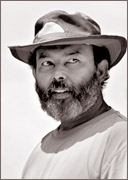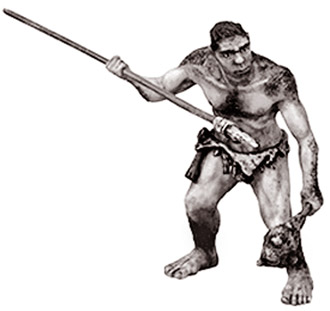Prehistoric man emerges from Haldummulla
By Amal HEWAVISSENTI
|

Prof. Raj Somadeva
|
A special team led by Prof. Raj Somadeva recently made spectacular
findings on a series of excavations which underpin the idea that Sri
Lankan Culture is not something borrowed from any country or region. The
excavations carried out in Haldummulla and Ranchamadama of Embilipitiya
on Walawe valley offer a convincing but rather unexplicit picture of
prehistoric man's transition to agricultural mode from hunting culture.
According as Prof. Raj Somadeva says, the generalised view that the
arrival of Aryans in Sri Lanka served as the perfect recipe for Sri
Lankan culture falls to complete refutation as marks of a well organised
prehistoric culture and civilisation begin to come- out from the earth.
Considerable evidence of the hunting life of prehistoric man were
earlier found in minor excavations and caves at Belilena, Pahien lena of
Bulathsinhala, Batadomba lena of Kuruwita etc. What made him to leave
high lands (such as Horton Plains) and settle down in lower regions of
the country?
Haldummulla - the focal point
 Dr.
Shiran U. Deraniyagala believes that Horton Plains where Sri Lankan
prehistoric man had inhabited was hit by a large scare drought that
virtually left Horton Plains scorched and rendered it unfit for human
habitation. The man migrated to the lower regions such as Haldummulla
and Ranchamadama of Embilipitiya - regions which from time to time
presented archaelogical riddles but concrete proof that prehistoric man
lived there. Dr.
Shiran U. Deraniyagala believes that Horton Plains where Sri Lankan
prehistoric man had inhabited was hit by a large scare drought that
virtually left Horton Plains scorched and rendered it unfit for human
habitation. The man migrated to the lower regions such as Haldummulla
and Ranchamadama of Embilipitiya - regions which from time to time
presented archaelogical riddles but concrete proof that prehistoric man
lived there.
The expedition headed by Prof. Raj Somadeva is excavating in a site
near Haldummulla town - a few metres off the Tamil school in Badulla
district. This freezing region of excavation is situated 835 metres
above sea level on the Southern Platform of central hills and is the
oldest recognisable human settlement at a geographically staggering
height. The generally accepted view that foreign Aryans fully
represented the Sri Lankan culture is challenged by the arguments
formulated by Shiran Deraniyagala and Raj Somadeva on the evidence of
the prehistoric man's existence with a certain culture. If Aryans
symbolised the civilization in Sri Lanka, what could really have
happened to the prehistoric man who had excelled in bronze technology?
However, since recently successful researches into the lifestyle of
Sri Lankan prehistoric man have been unravelling interesting things
which have thus far remained under a blanket of mystery. The
archaeological study on the prehistory of Sri Lanka commenced with the
excavations in Ranchamadama Upper and Ranchamadama Lower in 2005. In the
course of these careful probings, the team managed to see more and more
human remains being unearthed. They uncovered prehistoric graves and
human settlements on the Walawe Valley.
Currently the team are excavating sites in Haldummulla as their focal
point of research and have succeeded in discovering earliest graves and
tools same as what was found in Ranchamadama.
Migration from highlands
According to Prof. Raj Somadeva, this evidence represents the man's
transition to agricultural lifestyle from hunting in stone age and what
has been unearthed, will create a cross-section of man's evolution with
social customs around 3000 years back. The stone tools and graves
uncovered in Ranchamadama and Haldummulla represent more or less the
same period. Yet the fragments of pottery and stone tools (dating back
to 1129 BC) and other archaeological evidence that were discovered in
'home excacations' in Ranchamadama somewhere in 2009 prove that Sri
Lankan prehistoric man migrated from higher Haldummulla to lower
Ranchamadama later.
As Raj Somadeva points out, the Horton Plains which the Sri Lankan
prehistoric people are believed to have inhabited is situated some 2000
feet above Haldummulla which itself is a mountainous region. Therefore,
people living in the hills gradually migrated to lower plains around
5000 BC probably owing to the widespread drought which hit the highlands
specially Horton Plains during that time. In their journey to the
plains, or lower regions of the island, the people found some special
stones with a concentration certain metal in them. (These stones were
found trapped in the precipices).
It was these stones that were found deposited in the graves. The team
have managed to unearth some tools that have been produced precisely in
line with advanced bronze technology in the course of excavations in
Ranchamadama. This clearly shows that prehistoric man's hunting life
drastically changed when they discovered bronze.
It is the professor's firm conviction that the nature of fragments of
pottery, stone tools and bronze tools discovered in excavations in
Haldummulla, and Ranchamadama of Embilipitiya is the best proof of
conclude that Sri Lankan prehistoric man has been instrumental in
establishing Sri Lankan culture, not foreign migrants. The team led by
Prof. Raj Somadeva unearthed a prehistoric grave on the old road from
Haldummulla town to Soragune Devale. The excavated site which had been
exploited as a crematorium for dead people offers a glimpse of the human
society and social customs of the prehistoric man in Sri Lanka.
Comments Prof. Raj Somadeva further, "We excavated the graves on the
way to Tamil Mahavidyalaya of Haldummulla in the year 2010. We managed
to unearth three large funeral vessels of clay resembling boats made of
clay. There were pots filled with funeral ashes which we traced back to
1750 BC. We wanted to explore more about the human group who had used
these graves and crematorium. Above all, these finding belong to a
period some 3750 years ago. This is the grave discovered from the
highest elevation thus far (near the famous world's end). However, the
excavated grave provided limited picture of the human settlement as it
revealed only the facts about funeral rites. We excavated the sites in
Haldummulla and found remains of human habitation which lay adjacent to
the graves and which included tools and pottery resembling to what was
found in graves..."
Homes
"These houses have been built on foundations made of unhewn stone.
The foundation had long been covered by a huge stones that had rolled
down from atop the mountain. On the excavations of these houses, we
found painted pots, some tools of iron, a ring and some beads made from
clay. These remains speak volumes for the prehistoric man's enthusiasm
for fashionable living. At the sametime, the prehistoric man has
skillfully used iron for various purposes. They have uncovered blackish
red fragments of pottery and stone tools among the remains..."
The graves
"We have found several crematoriums constructed together. We have
named them funeral boats". This complex of funeral boats has been
constructed on a dangerously precipitous area and have been planned to
suit the size of average human body. The burnt earth inside these
funeral boats shows that there has been a certain burning inside them.
The makers of the funeral boats have been particularly attentive to
the physical nature of the land probably because of the dangerous
sloppiness of the area. They have selected places of hard soil and rocky
spots to construct the funeral boats in order to protect them from wash
away violently.
The most striking finding inside these funeral boats was fragments of
pots made with the potter's wheel and tools made of stones which had a
higher concentration of iron in them."
"We can guess that prehistoric people in Sri Lanka had the practice
of burning the deceased member of their family after the dead body has
decayed in the pit in the ground. It appears fair to say that they have
brought the decayed bones flesh and skin that were taken out of the pit
into a crematorium and burned everything there. The ashes seem to have
been deposited in the funeral boats. This practice is assumed to have
taken root because of prehistoric man's need to establish the ownership
of property by their families or generation..."
Professor Raj Somadeva identifies the powers and levels of status
attributed to certain families in overall organisation of the
prehistoric society.
He is of the view that the fundamental factor for building a
civilisation is the knowledge of bronze technology and the works of
prehistoric man uncovered in the Haldummulla excavations proves
prehistoric man's expertise in bronze technology.
The practising of funeral rites and the employment of potter's wheel
were the distinctive marks of the primitive agricultural society.
Therefore, as Prof. Somadeva aptly points out, the use of funeral boats
clearly displays a social custom during the period in question and
funeral rites were observed with religious connotations. The remains
uncovered in Haldummulla signals prehistoric man's transition from
hunting culture to the agricultural lifestyle. However the research
excavations are still in experimental stage.
Based on a discussion with Prof. Raj Somadeva |

